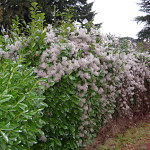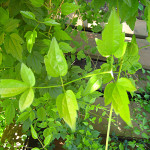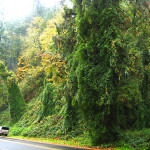
Old man’s beard or traveler’s joy (Clematis vitalba) is a perennial, woody vine that is sadly becoming increasingly common in our district and has the potential for devastating impacts. It grows rapidly, is a prolific seed producer, and can spread vegetatively. Currently more common in urban or residential areas it is quickly spreading out into agricultural and natural areas.
It climbs and blankets existing vegetation, starving trees and bushes of sunlight, eventually killing them. Clematis vitalba does some of its worst damage when it grows vertically, but it will also create dense mats of vegetation on the ground preventing the regeneration of new plants.
Identification
- Old mans’ beard’s white flowers are arranged in clusters which later turn into fluffy seed pods.
- The white, puffy balls of seeds are what gives Old man’s beard its name, and are an easy way to identify the plant in the fall and early winter.
Old man’s beard is sensitive to contact, meaning it has the ability to become tightly twisted around suitable objects like trees, shrubs, and fences. Its vines can rapidly grow up to, if not over 100 feet long and can be as thick as 6 inches or more in diameter. Old man’s beard is deciduous, with compound, opposite leaves usually arranged with five leaflets.
In summer, its white flowers are arranged in clusters which, in fall, turn into seeds bearing distinct long feathery tails giving this plant its name. The white, puffy balls of seeds are easily noticeable hanging out of trees and other objects in the late autumn and early winter after leaves have fallen from trees. Old man’s beard can easily be distinguished from English Ivy in the winter because it loses its leaves, and Ivy does not. If you see a woody vine wrapped around and hanging from a tree in the winter and it has no leaves it is almost certainly Old man’s beard.
Control
- Old man’s beard is deciduous, and the leaves will drop in the winter, leaving bare, woody vines.
- Clematis climbs and blankets existing vegetation, starving trees and bushes of sunlight.
If you live east of the Sandy river, free control is available through EMSWCD. If you live outside our control area, don’t be discouraged. There are some easy steps you can take to stop the invasion. Remember, the earlier you begin control of this species, the less time and money its control will take. Old Mans Beard is easiest to control when it is still a seedling. First and second year plants can be dug up by hand. Be sure to extract all root material and dispose of any woody debris from this plant in the trash, as Clematis has a tendency to root down wherever it is touching soil.
The best way to kill established, climbing populations is to sever the vine around waist height. Herbicide must be applied to the cut surface of the rooted stalk to permanently kill the vine. If you don’t want to use herbicides, you should cut the vine to the ground throughout the year in order to keep it from spreading seed. If you wish to tackle an infestation, give us a call and we can help you with a treatment plan and answer other control questions.
Report Sightings!
If you think you have found this plant please report it immediately. This plant is on our EDRR list, and we provide free control east of the Sandy River. Unfortunately, due to the abundance of this species in other areas, we cannot offer free control everywhere. Report a sighting!
More Photos
To see more photos of old man’s beard click here




